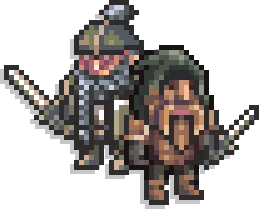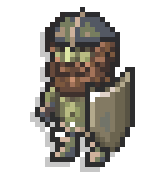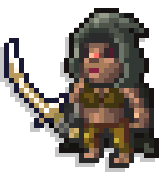- v50 information can now be added to pages in the main namespace. v0.47 information can still be found in the DF2014 namespace. See here for more details on the new versioning policy.
- Use this page to report any issues related to the migration.
Combat skill
v53.08 · v0.47.05 This article is about the current version of DF.Note that some content may still need to be updated. |
Combat skills are a collection of different but interrelated skills that, without exception, have an impact on dwarves' and other creatures' combat effectiveness.
General combat skills[edit]
General combat skills are a category of skills that are collectively unrelated to whether a dwarf (or human, perhaps leaf-lover) is using weapons or armor, but are useful for combat.
- Archer - increases with the use of any ranged attack, including throwing. Its exact function is unknown, except that it was shown to decrease the probability of an enemy dodging a ranged attack. Aside from that, it can serve as an indicator of how much ranged weapons are used.
- Biter - increases whenever a character chooses to bite an opponent. This is probably the most effective attack for a creature whose biting causes a syndrome, but some immigrants will arrive with this skill as well, and unarmed combatants will occasionally learn a little of this skill when they choose to bite during a combat. Goring with horns and tusks also uses the biting skill.
- Dodger - aids creatures in avoidance, causing enemies to miss more often. Scanning of combat reports suggest that dodging is very common and effective - assuming that messages referring to dodging are in essence caused by the dodger skill. Dodging can, unfortunately, cause creatures to fall through Z-levels into deep pits, water, or even magma; they do not attempt to avoid dodging into perilous locales. Dodging can even be done while lying on the ground, making it a particularly valuable skill.
- Fighter - increases with each melee attack (from or to a target), no matter what kind of weapon is used, and can increase rather quickly. It influences weapon accuracy, though to a lesser extent than particular weapon skills.
- Kicker - increased by kicking in unarmed combat. Stance strikes from kicking and tail slapping tend to have a blunt attack type, though stings from a bark scorpion man will also rely on the kicking skill.
- Striker - increased by throwing punches and scratching with claws or nails in unarmed combat; creatures with pincers will snatch at targets instead.
- Wrestler - pertains to incapacitating enemies by grabbing and holding limbs. Wrestlers are generally unable to kill much, but they may make killing easier for their armed comrades - and their punches do kill fellow dwarves when tantruming. Wrestlers can strangle enemies unconscious, break joints, and even take away weapons and armor, but the AI is rather unlikely to do so (making adventurer-wrestlers much more effective).
- Observer - used to note and anticipate the attacks of enemies. Skilled observers are less likely to be surprised by an opponent's charge, for instance, and less likely to receive a penalty for being attacked from the side. In adventure mode, higher levels of the skill also give more information - which arm/weapon the opponent is using for its next attack, for example.
Your "deflection roll" is based on your armor use skill, but in the first calculation, your dodge roll counts more and replaces your deflection roll if it is higher. That roll is thrown into an equation with the hit roll to get the "squareness" of the attack from 0 to 20. There's some pure luck at this stage, though, and the squareness can sometimes be increased regardless of the rolls. Later, the same deflection roll is used directly with relevant worn items one by one to modify attack momentum using the material/etc. -- dodge rolls don't enter into this. Item familiarity can increase this deflection bonus.
In addition to speed, high armor skill also decreases your "clunkiness" with heavy worn objects. The clunkiness sum applies a minus to many skill rolls (mostly combat, but a few non-combat skills).
Equipment skills[edit]
Equipment skills are associated with the use of non-weapon equipment, and as a class increase dwarven survivability.
- Armor User - related to how well a dwarf moves in armor, and increases whenever a dwarf wearing armor attacks or is attacked, with triple the gain if the dwarf was actually struck on their armor. Higher levels of this skill reduces the encumbrance penalties of armor, allowing dwarves wearing full steel plate and shield to move at normal speed. Arena testing also indicates that armor users become tired less easily than non-armor wearers (300 vs 100 announcements vs bronze colossus). Because even leather clothes count as armor, this skill often appears at dabbling level on civilians who briefly struggle with a kobold thief or predatory animals. A creature with a tough enough body will also gain armor user skill when glancing blows are struck to their bare flesh(?), though anything durable enough to do that would have little need for normal armor. Armor User skill possibly used for shield-based attacks.
|
|
|
[Verify]
- Shield User - increases whenever a dwarf uses a shield or buckler to block an attack, which is often. Shields increase the survivability of dwarves a great deal, and can block anything from a goblin axe to dragonfire.
Weapon skills[edit]
Weapon skills are associated with the use of a particular weapon type, even if that weapon type is "thrown vomit" in adventure mode. Arena testing indicates weapon skill is more powerful per-point than any other combat skill (assuming the appropriate weapon is equipped!), it contributes to offensive ability and parrying. The name of many of these skills is dependent on species: a dwarven spear user will be known as a 'Speardwarf'. The fighter skill does everything these do, but less.
- Axeman - allows characters to use battle axes, great axes, and halberds more effectively.
- Blowgunner - allows characters to use blowguns more effectively.
- Bowman - allows characters to use bows more effectively. ("Bowdwarf" for dwarves).
- Crossbowman - allows characters to use crossbows more effectively. ('Marksdwarf' for dwarves).
- Hammerman - allows characters to use mauls and war hammers more effectively, as well as crossbows in melee.
- Knife User - allows characters to use large daggers and knives more effectively.
- Lasher - allows characters to use whips and scourges more effectively.
- Maceman - allows characters to use flails, maces, and morningstars more effectively.
- Miner - not strictly a weapon skill, but allows characters to use picks more effectively as weapons. This is also the only moodable combat-usable skill.
- Misc. Object User - allows characters to use objects like tables and chairs (etc.) more effectively as weapons. In fortress mode, dwarves will often use this skill when attacking with held goblets. It also is used with shields, making it useful if a military dwarf is disarmed (either literally or not).
- Pikeman - allows characters to use pikes more effectively.
- Spearman - allows characters to use spears more effectively.
- Swordsman - allows characters to use long swords, scimitars, short swords, and two-handed swords more effectively, as well as blowguns and bows in melee.
- Thrower - allows characters to throw miscellaneous objects more effectively. Throwing is still as hilariously overpowered as in previous versions - you can, for instance, kill a charging elephant with thrown water. This generally isn't seen in fortress mode, other than the occasional dwarf going on a tantrum and throwing whatever is in their hands.
See also[edit]
- Outstanding research on several combat skills by Shinziril
- A scientific test of how the Archer and Marksdwarf skills affect ranged combat: Dwarven Research: A Study of the 'Archer' and 'Marksdwarf' Skills
- A Marksdwarf Training Guide is available to handle many issues and confusion relating to marksdwarves, as well as provide methods to get them more reliably training and firing.
- Dwarven Research: A Study on Shielding Explains everything you need to know about shields.
| Miner | |||||||
|---|---|---|---|---|---|---|---|
| Woodworker | |||||||
| Stoneworker | |||||||
| Ranger | |||||||
| Doctor | |||||||
| Farmer | |||||||
| Fishery worker | |||||||
| Metalsmith | |||||||
| Jeweler | |||||||
| Craftsdwarf |
Bookbinder · Bone carver · Clothier · Glassmaker · Glazer · Leatherworker · Papermaker · Potter · Stone crafter · Strand extractor · Wax worker · Weaver · Wood crafter | ||||||
| Engineer | |||||||
| Administrator | |||||||
| Military |
| ||||||
| Social |
| ||||||
| Performance |
| ||||||
| Scholar |
Critical thinker · Logician · Mathematician · Astronomer · Chemist · Geographer · Optics engineer · Fluid engineer · Wordsmith · Writer | ||||||
| Other/Peasant | |||||||
| Unused | |||||||


